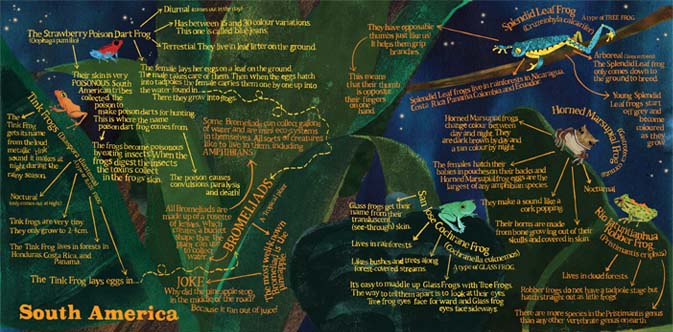 My Dad likes to take a “stroll around the block” of an evening. I think that’s an interesting expression because a “block” is an American term. We don’t really have blocks here do we? My Granddad on my Dad’s side had a florist’s shop in New York for a while so I had wondered if that’s how the expression had come to be part of my Dad’s parlance. When I voiced this thought to my in-laws they said that their parents often used the phrase and it probably came from watching American movies. So much for my theory. Nevertheless, going for a stroll around the block is something I often find myself yearning to do of a dimpsy Devon evening, and I wondered if I might use it to explore the beating the bounds idea a bit more.
My Dad likes to take a “stroll around the block” of an evening. I think that’s an interesting expression because a “block” is an American term. We don’t really have blocks here do we? My Granddad on my Dad’s side had a florist’s shop in New York for a while so I had wondered if that’s how the expression had come to be part of my Dad’s parlance. When I voiced this thought to my in-laws they said that their parents often used the phrase and it probably came from watching American movies. So much for my theory. Nevertheless, going for a stroll around the block is something I often find myself yearning to do of a dimpsy Devon evening, and I wondered if I might use it to explore the beating the bounds idea a bit more.
Dove Grey Reader (the blogger who inspired these beating the bounds thoughts) marked out the circumference of a mile around her cottage and walks this route regularly, taking in all she can, and getting to know the landscape intimately over the seasons. Having discovered the parish tithe map online thanks to Devon County Council I laid the old parish on top of my OS map and worked out roughly where the boundary would have gone. Some of the boundary is over private land so inaccessible, including, annoyingly, one of the old boundary stones. It’s also been chopped up by new roads and a new industrial estate near the river so I’ve had to adapt a bit. It’s also a really big parish. It would probably take me the best part of a day to walk the whole thing. So instead, I’ve been walking loops from the house, where the top part of the loop takes in part of the parish boundary.
The first of these meant heading west across two residential streets, circling a large park, walking up another residential street, across a busy road and then joining a path that runs up beside the allotments to the fields beyond. This hill has a lovely name, it is called Roly Poly hill and is a countryside corridor which allows those of us in the parish with green hearts to get our countryside fill without the need for an ignition key. There are in fact two paths that run up either side of the allotments and both are on the 1841 tithe map, which makes me think that this hill has always been an important country link for the people living in our parish. One has a name, Crabb Lane, further over the hill becoming a properly metalled road, but my path is anonymous. It is enclosed by steep banks on both sides, covered in all sorts of shade and damp-loving plants. At the top of the hill it was worth a pause under a copse of mixed deciduous trees to look back over the city to survey the hustle and bustle from a peaceful distance.
Turning back to the West, the hill gives way steeply to hedgerowed fields and wooded combes, jumbling their way to the horizon. The south-westerly orientation of the hill side makes it perfect for the growing conditions required by the fruit farm that occupies the fields. At the bottom of the hill is a brook, reputedly home to otters and kingfishers. The parish boundary doesn’t go as far down as the brook, but heads along an old Saxon lane that runs along the ridge of Roly Poly hill. It’s not metalled but is wide enough for me to imagine carts of long ago bumping their way along it. Parts of the hedgerow here are over 400 years old.
I took a brief detour down a footpath to visit a wonderful old tree known locally as the Twisted Oak, which does indeed have a distinctive spiral twist to its trunk. This tree is thought to be over 250 years old, and marks an important confluence of ancient routes. There has been a bridge crossing the brook here since at least 1244. This side of the hill, down to the brook is a conservation area. There are several listed buildings around here, including some thatched cottages that date back to medieval times. Standing beneath the oak tree I watched insects dancing in the warm evening sunshine which penetrated the canopy in spotlights, and crossed my fingers that some big developer hasn’t already got his name on the land deeds, the precious green space subdivided in his mind into plots for rabbit hutch houses.
Pushing aside gloomy thoughts about how much green space seems to be disappearing under concrete or tarmac, I strode back up the hill to rejoin the Saxon lane. Where the lane comes out onto a modern road, which follows another ancient route out of the city, there is a medieval granite cross, standing sentry. I gave it a salute and headed off back down the hill and to home.
The frogs are a sample spread I did for a book about amphibians.
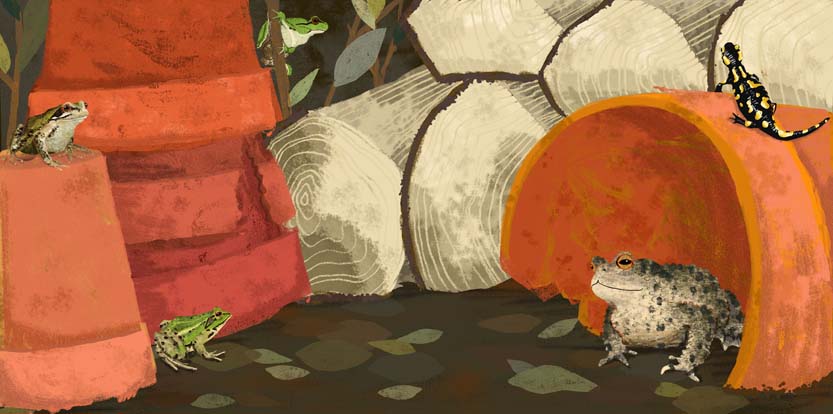 Wren and Finch are big fans of carbohydrates. They would live entirely on bread, potatoes and pasta if they could. Finch’s potato passion reached new heights with this season’s jersey royals so he was utterly disgusted when we made a potato salad with some last week. “Why are the potatoes dirty?” he asked prodding the mayonnaise dressing with disgust. Needless to say all ‘dirt’ had to be wiped off the potatoes before he would touch them. What a relief to find potato perfection was still there under all that awful creamy stuff!
Wren and Finch are big fans of carbohydrates. They would live entirely on bread, potatoes and pasta if they could. Finch’s potato passion reached new heights with this season’s jersey royals so he was utterly disgusted when we made a potato salad with some last week. “Why are the potatoes dirty?” he asked prodding the mayonnaise dressing with disgust. Needless to say all ‘dirt’ had to be wiped off the potatoes before he would touch them. What a relief to find potato perfection was still there under all that awful creamy stuff!

 My Dad likes to take a “stroll around the block” of an evening. I think that’s an interesting expression because a “block” is an American term. We don’t really have blocks here do we? My Granddad on my Dad’s side had a florist’s shop in New York for a while so I had wondered if that’s how the expression had come to be part of my Dad’s parlance. When I voiced this thought to my in-laws they said that their parents often used the phrase and it probably came from watching American movies. So much for my theory. Nevertheless, going for a stroll around the block is something I often find myself yearning to do of a dimpsy Devon evening, and I wondered if I might use it to explore the beating the bounds idea a bit more.
My Dad likes to take a “stroll around the block” of an evening. I think that’s an interesting expression because a “block” is an American term. We don’t really have blocks here do we? My Granddad on my Dad’s side had a florist’s shop in New York for a while so I had wondered if that’s how the expression had come to be part of my Dad’s parlance. When I voiced this thought to my in-laws they said that their parents often used the phrase and it probably came from watching American movies. So much for my theory. Nevertheless, going for a stroll around the block is something I often find myself yearning to do of a dimpsy Devon evening, and I wondered if I might use it to explore the beating the bounds idea a bit more.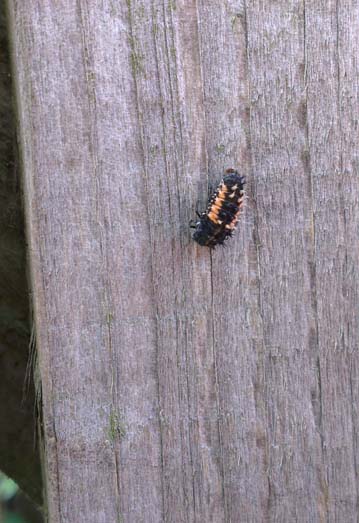 It has been so hot here. All the doors and windows of the house are flung wide open. Wren sleeps in just her nappy but only fitfully. She wakes up grumpy, her curls plastered to the back of her neck. At the weekend we paddled in a cool lake on Dartmoor, and admired banks of purple foxgloves down shady woodland paths.
It has been so hot here. All the doors and windows of the house are flung wide open. Wren sleeps in just her nappy but only fitfully. She wakes up grumpy, her curls plastered to the back of her neck. At the weekend we paddled in a cool lake on Dartmoor, and admired banks of purple foxgloves down shady woodland paths.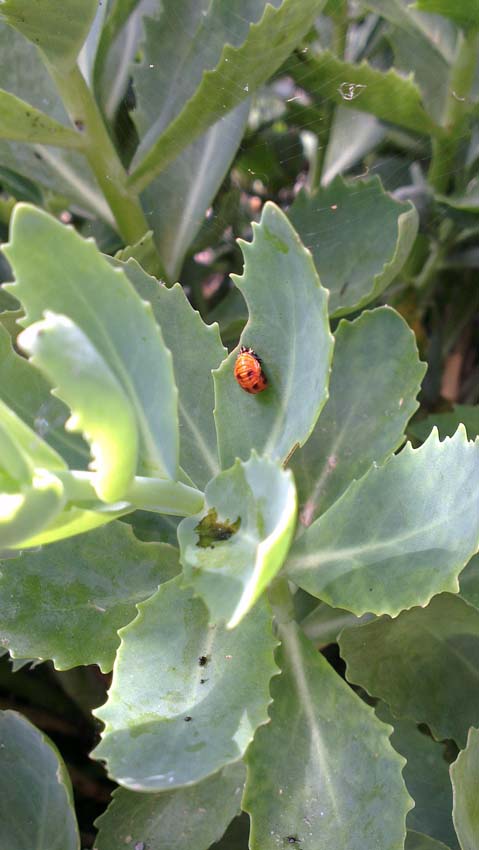 Ladybirds hibernate over winter, wake up, mate and then lay their eggs. I had noticed these funny little black and red beetley creatures (see the first pic above) but didn’t know that this is what baby ladybirds look like! And I didn’t know that their absolute favourite thing to eat is an aphid! It was only when they started attaching themselves by one end to various leaves and the garden gate that I realised they were all slowly turning into ladybirds! Here’s one, well on its way. I think it will be a seven-spot. I wonder how long this cycle has been happening? Ladybird parents eye up the maple in late summer, thinking to themselves, that’ll be covered in aphids next spring, I’ll just have a little kip here then nip down and lay my eggs nearby when the time comes. Lo and behold the aphids turn up, the baby ladybirds hatch and feast away, the maple breathes a hearty thanks, the baby ladybirds grow up to be ladybird parents, and so it goes on.
Ladybirds hibernate over winter, wake up, mate and then lay their eggs. I had noticed these funny little black and red beetley creatures (see the first pic above) but didn’t know that this is what baby ladybirds look like! And I didn’t know that their absolute favourite thing to eat is an aphid! It was only when they started attaching themselves by one end to various leaves and the garden gate that I realised they were all slowly turning into ladybirds! Here’s one, well on its way. I think it will be a seven-spot. I wonder how long this cycle has been happening? Ladybird parents eye up the maple in late summer, thinking to themselves, that’ll be covered in aphids next spring, I’ll just have a little kip here then nip down and lay my eggs nearby when the time comes. Lo and behold the aphids turn up, the baby ladybirds hatch and feast away, the maple breathes a hearty thanks, the baby ladybirds grow up to be ladybird parents, and so it goes on.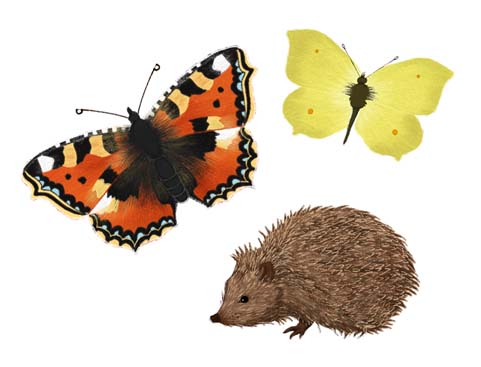 My Dad has a conspiracy theory about microwaves. It goes like this. Whichever way he puts his mug of coffee into the microwave, it always finishes with the mug handle turned away from him when he goes to get it out. He has tested this theory on numerous appliances and it is always the case. Move over terrorists, microwaves are the new threat undermining our way of life and blighting elevenses everywhere!
My Dad has a conspiracy theory about microwaves. It goes like this. Whichever way he puts his mug of coffee into the microwave, it always finishes with the mug handle turned away from him when he goes to get it out. He has tested this theory on numerous appliances and it is always the case. Move over terrorists, microwaves are the new threat undermining our way of life and blighting elevenses everywhere! Rain is gently tip-tapping on the window this morning. In the garden a
Rain is gently tip-tapping on the window this morning. In the garden a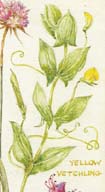 In the hedgerows I can see greater stitchwort, field roses and elderflowers. I spotted a bright pink vetchling tangled up with
In the hedgerows I can see greater stitchwort, field roses and elderflowers. I spotted a bright pink vetchling tangled up with 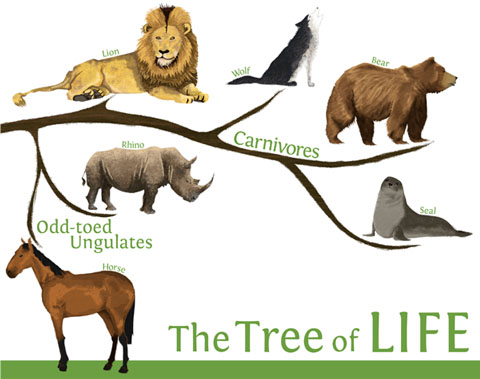 A blog I love to read is called
A blog I love to read is called  Finch got some new pyjamas this week. He was so pleased with them that he got up in the night and put all three sets on, on top of each other. He was roasting when we went to wake him up in the morning. There are lots of yellow irises flowering along the river, beautiful golden spears, tall and exotic. My rambling roses are blooming and the bees are busy visiting the chives. After a week of non-stop rain the forecast is for sun! At long last summer might be here…just in time for May half term.
Finch got some new pyjamas this week. He was so pleased with them that he got up in the night and put all three sets on, on top of each other. He was roasting when we went to wake him up in the morning. There are lots of yellow irises flowering along the river, beautiful golden spears, tall and exotic. My rambling roses are blooming and the bees are busy visiting the chives. After a week of non-stop rain the forecast is for sun! At long last summer might be here…just in time for May half term.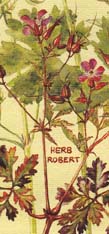 Wren fell into the toy box like a sky diver this week; head first, arms back. All I could see was a pair of legs back-pedaling frantically. She also attempted to eat a ladybird. We’ve had loads of ladybirds in our house recently and I have spent a significant amount of my time collecting them from the landing window sill and putting them outside. I’m guessing they’ve been hibernating around the house and have all suddenly woken up. The unfortunate one that went in Wren’s mouth was hurrying along the kitchen floor when she spotted him. He obviously realised he’d been clocked because he stopped stock still, but it was too late. She’s at that stage where absolutely everything goes in her mouth so a ladybird was no exception. By the time I’d leapt over to her all I could do was fish the poor thing out with my finger but he was a goner.
Wren fell into the toy box like a sky diver this week; head first, arms back. All I could see was a pair of legs back-pedaling frantically. She also attempted to eat a ladybird. We’ve had loads of ladybirds in our house recently and I have spent a significant amount of my time collecting them from the landing window sill and putting them outside. I’m guessing they’ve been hibernating around the house and have all suddenly woken up. The unfortunate one that went in Wren’s mouth was hurrying along the kitchen floor when she spotted him. He obviously realised he’d been clocked because he stopped stock still, but it was too late. She’s at that stage where absolutely everything goes in her mouth so a ladybird was no exception. By the time I’d leapt over to her all I could do was fish the poor thing out with my finger but he was a goner. The swifts are back! They have been screeching loudly as they swerve and swoop over our heads. Little Owl and I went on an early morning outing with our local Wildlife Trust on Sunday to hear the dawn chorus. It was a real trauma dragging ourselves out of bed at 4am I can tell you, but totally worth it. We zipped up our body warmers and slipped out into the dark, silent streets. Little Owl was thrilled to be out on such an early morning escapade. She was in charge of the torch and its beam bobbed about merrily as she skipped along the pavement.
The swifts are back! They have been screeching loudly as they swerve and swoop over our heads. Little Owl and I went on an early morning outing with our local Wildlife Trust on Sunday to hear the dawn chorus. It was a real trauma dragging ourselves out of bed at 4am I can tell you, but totally worth it. We zipped up our body warmers and slipped out into the dark, silent streets. Little Owl was thrilled to be out on such an early morning escapade. She was in charge of the torch and its beam bobbed about merrily as she skipped along the pavement.




